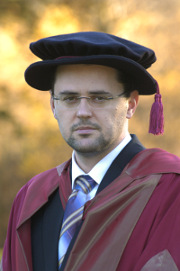Development of the stress trajectories method for stress field reconstructions in plane plasticity.
 Peter Haderka has recently passed his PhD viva at the Wessex Institute of Technology with a thesis entitled ‘Development of the stress trajectories method for stress field reconstructions in plane plasticity’. His external examiner was Prof. Daniel Lesnic from the University of Leeds and the internal examiner was Prof. Stavros Syngellakis.
Peter Haderka has recently passed his PhD viva at the Wessex Institute of Technology with a thesis entitled ‘Development of the stress trajectories method for stress field reconstructions in plane plasticity’. His external examiner was Prof. Daniel Lesnic from the University of Leeds and the internal examiner was Prof. Stavros Syngellakis.
Peter received his Master of Science from the Slovak Technical University in the field of Applied Mechanics. He came to WIT in 2008 and started a PhD programme under the supervision of Prof. Alexander N. Galybin.
The thesis was devoted to developing and verifying new numerical methods for the determination of the full stress tensor in two-dimensional plastic bodies. The approach was developed in accordance with the basic principles accepted in the theory of plasticity. The Cauchy boundary value problem was manipulated in order to obtain the solution along the trajectories of the principal stresses. The characteristic attribute of the proposed method was that it utilized the orientation of the principal stresses as one of the boundary conditions. The second condition was formulated in terms of the mean or Tresca stress via the normal derivative of the principal directions. While the former is typical for engineering applications the latter is important in geophysics.
The numerical method employs the finite-difference scheme that, in contrast to the conventional approach (that builds a network of slip lines), builds a pattern of two orthogonal families of the stress trajectories. A new concept of alternations to the solutions based on the slip lines and the stress trajectories, allowing significant extension of the domain where the plastic stress state can be identified, was developed. The proposed approach was verified for problems arising in engineering; namely, plates with circular holes loaded by pressure and stability of foundations; and in geodynamics; for modelling of regional tectonic stresses in the Earth’s crust.
The problems of the stress reconstruction in plastic regions of the lithosphere were investigated in close conjunction with the stress indicators of the World stress map project database (release 2008). The application of the method was tested both in view of the well- (Antarctic tectonic plate) and ill-posed (chosen regions in Swiss Alps, Tibetan plateau and Eastern Anatolia) formulations of the boundary value problem. The reconstructed stress fields were compared against the World Stress Map project’s experimental data available inside the regions and the best fit to the data was sought by varying the strength parameters of the yield conditions.
Both examiners congratulated Peter on the work presented and recommended that he be awarded the degree Doctor of Philosophy.

 Wessex Institute
Wessex Institute